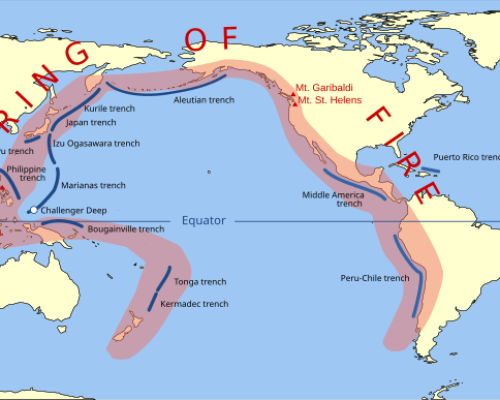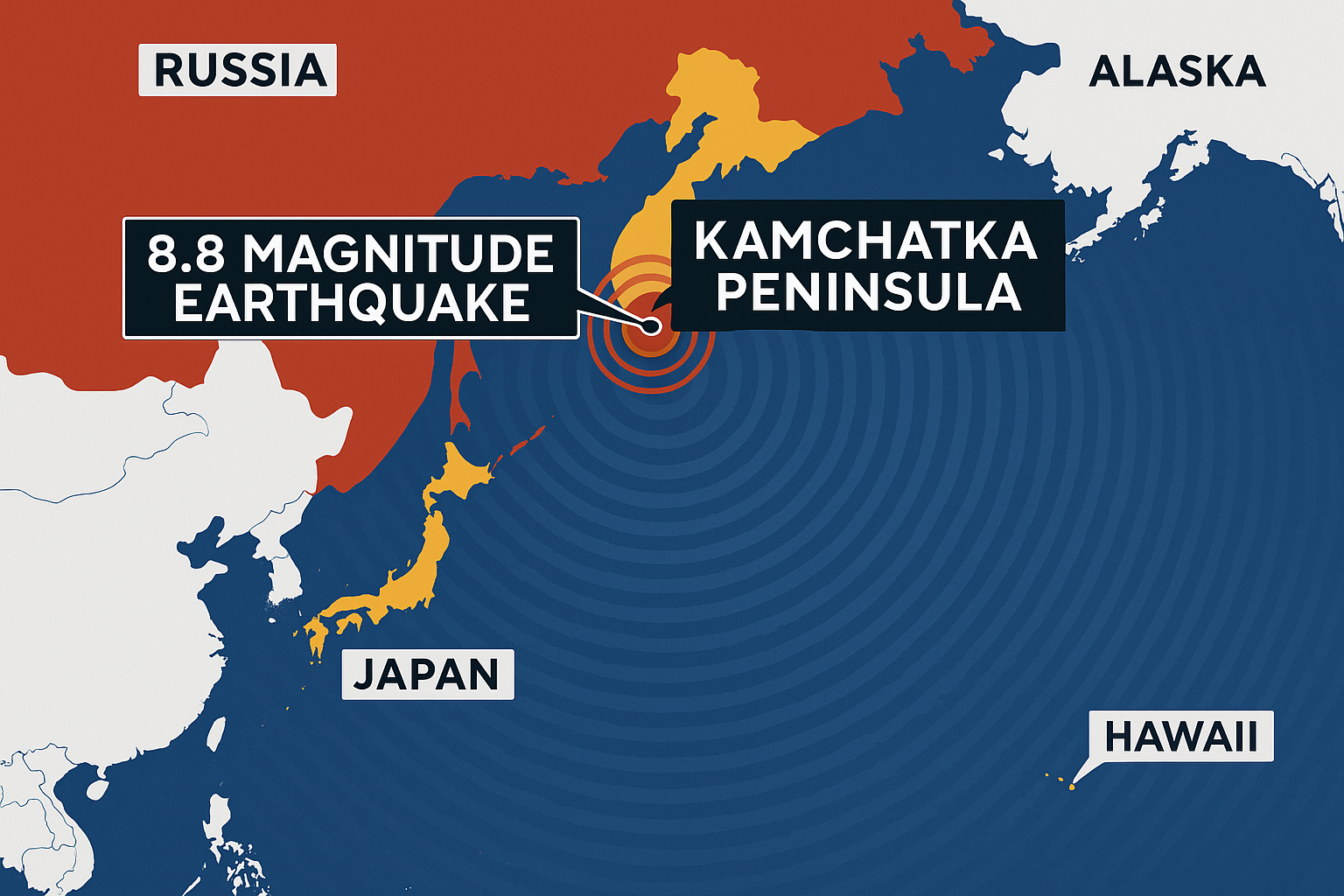Table of Contents
Introduction
In a powerful reminder of the Earth’s seismic volatility, a massive earthquake measuring 8.8 on the Richter scale struck the eastern coast of Russia near the Kamchatka Peninsula. The tremor triggered immediate tsunami warnings in several regions, including Japan, Alaska, and Hawaii. As emergency protocols were activated across the northern Pacific, the event raised global concerns about preparedness and the rising frequency of such natural disasters.
The Ring of Fire: Earth’s Seismic Hotspot

The Russian Far East lies on the infamous “Ring of Fire”, a 40,000-kilometer horseshoe-shaped belt in the Pacific Ocean known for intense earthquake and volcanic activity. This region is defined by complex tectonic plate boundaries—particularly subduction zones, where one plate dives beneath another, building up immense pressure that is occasionally released as earthquakes.
Over 75% of Earth’s volcanoes and 90% of earthquakes occur along this ring. Countries like Japan, Indonesia, the Philippines, the west coast of the Americas, and Russia’s Kamchatka region are particularly vulnerable to seismic disruptions because of this geotectonic setup.
INCOIS Clarification No Threat to Indian Coast:
Soon after the Russian earthquake and tsunami warnings were reported across the Pacific, Indian National Center for Ocean Information Services (INCOIS), issued a statement reassuring Indian citizens that there is no tsunami threat to the Indian coast.
India’s proximity to the Sunda Trench makes tsunami drills vital for eastern coastal states like Tamil Nadu and Andhra Pradesh
Despite the intensity of the Russian earthquake and subsequent Pacific-wide tsunami warnings, Indian coastlines are not under threat as this seismic event occurred in the Pacific Ocean basin, far from the Indian tectonic zone,” INCOIS stated.
India is more directly influenced by seismic activity along the Indian Ocean, particularly the Sunda Trench (near Indonesia) and the Makran Subduction Zone (near Iran and Pakistan), not the Pacific Plate.
Global Reaction: USA and Beyond
The United States immediately activated its Pacific Tsunami Warning Center (PTWC), with tsunami watches issued for Alaska, Hawaii, and coastal communities along the Pacific Northwest. Sirens were sounded, and citizens were advised to move to higher ground or designated shelters.
In Japan, the Meteorological Agency raised tsunami warning advisories, particularly for coastal provinces with historical vulnerability to similar events most notably the devastating 2011 Tōhoku earthquake and tsunami.
New Zealand, Australia, and several Pacific island nations closely monitored developments, reinforcing communication with their disaster preparedness agents earthquake and tsunami warning
Notable quake, preliminary info: M 8.0 - 136 km ESE of Petropavlovsk-Kamchatsky, Russia https://t.co/pecsU8xcSy
— USGS Earthquakes (@USGS_Quakes) July 29, 2025
Why Are Tsunamis Increasing in Frequency?
Climate Change and Sea-Level Rise: Higher sea levels amplify the reach and impact of even minor tsunamis. Melting glaciers may be altering stress distributions in the Earth’s crust, subtly increasing tectonic activity.
Increased Seismic Monitoring: Modern detection systems are more sensitive and widespread. Events that might have gone unnoticed decades ago are now documented in real-time.
Undersea Volcanic Activity: Recent volcanic eruptions, like the Hunga Tonga–Hunga Haʻapai eruption in 2022, have demonstrated that tsunamis can originate from causes beyond earthquakes alone.
Coastal Urbanization: Expanding human populations and infrastructure in vulnerable coastal zones increase both exposure and the reporting of tsunami-related events.
Lessons for India and Other Nations
Although India was unaffected by this specific event, there are several takeaways:
- Strengthen Domestic Monitoring: Continued funding and support for institutions like INCOIS and IMD are essential.
- Public Education: Awareness campaigns in schools, coastal towns, and tourist areas about earthquake and tsunami safety protocols.
- Zoning and Infrastructure: Implementing stricter construction codes in vulnerable areas and discouraging unchecked coastal development.
India’s past experiences—like the 2004 Indian Ocean tsunami, which killed over 10,000 people domestically—should remain a driving force behind continuous disaster readiness efforts.
Solutions and Preparedness for Future Events
To reduce the impact of future earthquake and tsunami, a multi-layered strategy is essential:
1. Enhance Early Warning Systems: Invest in real-time underwater sensors, seismic buoys, and AI-driven models. Integrate alerts with mobile apps, TV, radio, and community sirens.
2. Coastal Risk Mapping: Identify high-risk zones using modern GIS tools. Relocate vulnerable communities where necessary.
3. Strengthen International Cooperation : Share satellite data, warning protocols, and simulation models with regional and global partners. Participate in global drills like the IOWave tsunami simulation exercises.
4. Build Resilient Infrastructure: Earthquake-resistant buildings in seismic zones. Elevated shelters and robust evacuation routes in tsunami-prone areas.
Conclusion
The 8.8 magnitude Russian earthquake in Kamchatka Peninsula and subsequent tsunami alerts across the Pacific serve as a global wake-up call. While India remains unaffected this time, the event underlines the importance of preparedness, international coordination, and public awareness.
As climate and tectonic systems evolve, the world must invest in resilience, not just response. With better planning, technological tools, and community readiness, nations can significantly reduce the impact of future disasters.
Project Vishnu: India’s New Hypersonic Missile
The GeoLens – India || Defence || Global Affairs

Pratik Kondawale
Strategist | Indian Defence & Global Affairs
Founder of GeoLens.in, Pratik writes in-depth analysis on India’s defence strategy, military tech, and global power shifts delivering sharp insights through an Indian lens.

You’re so interesting! I don’t suppose I have read something like this before. So nice to discover another person with a few genuine thoughts on this subject. Seriously.. many thanks for starting this up. This web site is something that’s needed on the web, someone with a little originality! http://www.kayswell.com